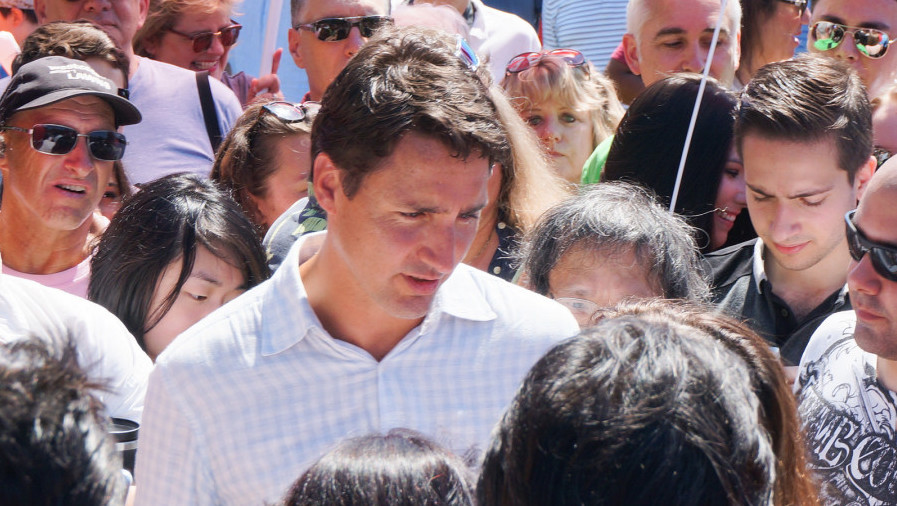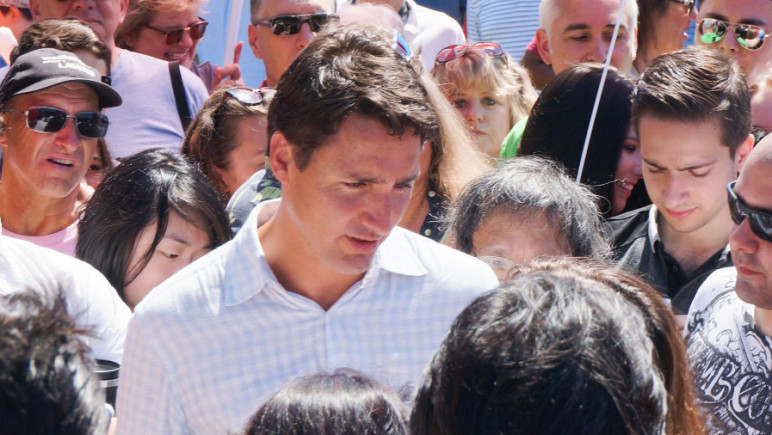Editor’s Note October 3, 2016: Did you hear the news? Canadian Prime Minister Justin Trudeau announced today that every Canadian province will have until 2018 to adopt a carbon pricing plan. To celebrate this key step forward in climate action, we are reviving this piece from earlier this year on Canadian perceptions of climate change. Now let’s hope that the United States can learn from Canada’s climate success and move forward on climate policy.
Prime Minister Justin Trudeau took provinces by surprise Monday by announcing they have until 2018 to adopt a carbon pricing scheme, or the federal government will step in and impose a price for them.
Majorities in every Canadian electoral district support emissions trading.
When it comes to climate change, Justin Trudeau, Canada’s new prime minister, seems to want a clean break from his Conservative predecessor, Stephen Harper. (As the Guardian reports, Harper has been accused of “muzzling government scientists and backtracking on climate promises.”)
Canada’s new Liberal government is talking of plans to price and cap carbon emissions. Provincial elections in 2015, including a new left-leaning government in Alberta which has already announced a carbon tax plan, may also boost the chances for Canadian climate solutions.
This month, Trudeau’s government held a National Climate Meeting in Vancouver with First Ministers and Indigenous leaders to develop a national climate policy framework for Canada. And just this week, four months after Trudeau’s election and eleven months before a new US president takes office, Trudeau and Barack Obama committed to work together on climate protections. They are expected to announce a series of common measures including a 45 percent cut in methane emissions from the oil and gas industry—a greenhouse gas that is roughly 80 times more potent than carbon dioxide—and protections for the Arctic (where scientists are now tracking the mildest winter ever recorded.)
With this window cracked open to North American cooperation and Canadian action, where do Canadians stand on climate issues?
Right on cue, the Yale Project on Climate Change Communications has mapped how Canadian perceptions of climate change, as well as support for carbon taxes and cap and trade, are distributed across the country, including projections by province and federal electoral district (or riding). (See also: Yale’s meta-analysis and interactive mapping of US climate opinions at the state, Congressional district, and county level.)
Here are some highlights:
- At the national level, 79 percent of Canadian voters acknowledge climate change is happening. (Compare that to 63 percent of US voters.) Quebec has the highest proportion of adults (85 percent) who say it’s happening, but even in Alberta, where belief is lowest, 67 percent understand climate change is happening.
- Local variation in Canada is significant. In Nova Scotia, for example, 87 percent say it’s happening, while only 66 percent in Saskatchewan agree; 56 percent say climate change is happening in the Souris-Moose Mountain riding in Saskatchewan compared to 91 percent in the riding of Halifax, Nova Scotia.
- Belief that the problem is real is lower in rural Canada, particularly across the Prairies. As the researchers point out, “The strongest levels of climate change belief exist in coastal BC, Quebec, Nova Scotia, and in urban areas across the country.” At the extreme, belief in climate change exceeds 90 percent of the public in the Quebec district of Laurier-Sainte-Marie, the district of Vancouver East, and the district of Halifax. That’s high! Yale mapping in the US tops out around 80 percent.
- Overall, belief in climate change is higher in Canada than in the US (as measured by Yale’s estimates for 2014). The low end of variation in Canadian beliefs map onto the middle of US variation.
- However, nationally, only 44 percent of Canadians think the cause is mostly human activities. US voters squeak ahead on this one, at 48 percent. It is in the six largest urban areas of Canada where people are most likely to see humans as the main cause. Notably, in Canada, belief that climate change is human-caused is lowest in the more greenhouse gas intensive parts of the country. “In other words, places that are more significantly contributing to climate change show lower beliefs that humans are the cause.” However, urban districts in Alberta show public opinion on this question closer to that of Ontario, Quebec, or BC.
- Despite these variations in core beliefs about the issue, there is widespread public support for climate policies. Majorities of the public in every federal electoral district (riding) support an emissions trading scheme. Support for emissions trading is highest in Quebec—71 percent—where a cap and trade system was implemented in 2013.
- Support for carbon taxes is more geographically differentiated, at 49 percent nationally (with opposition at 44 percent), but ranging from a low of 35 percent in the Northern Alberta riding of Fort-McMurray-Cold Lake to a high of 70 percent in the Montreal-area riding of Outremont. Support for carbon taxes is concentrated in urban Canada and British Columbia (where there is a carbon tax shift in effect).
- Support for carbon pricing policies is higher in provinces that have already implemented these policies. In other words, there is no evidence of a popular backlash against carbon pricing in places where people are experiencing them.
Canadians have lots of progress yet to make on attitudes and policy. But with the election of Justin Trudeau and like-minded leaders across Canada, the world’s climate may get a breath of fresh air.











Christopher Porter
Things may look sunny from an American perspective, but Trudeau has been a bit of a disappointment on the environmental front.
First, he promised to phase out fossil fuel subsidies, and then broke that promise in his first budget.
During the election he called the previous Conservative governments climate change targets inadequate, weak and catastrophic (which they are), but then adopted them last month without making any changes.
He campaigned for a renewed partnership with first nations, but last week approved a huge liquefied natural gas project in BC against the wishes of local first nations. That project alone will raise BC’s carbon emissions by over 20% and make it nearly impossible for Canada to meet it’s watered down climate goals.
Trudeau has talked a good game on the environment and climate change, but his actions haven’t matched his words. A national price on carbon might seem like a great accomplishment, but any climate progress is being overridden by the new mega fossil projects he’s approving.
Benoit
Agree 100% with Christopher, Jan and Barry
And more: WHAT ABOUT THE INFAMOUS ENERGY EAST PIPELINE
The Infamous pipeline that Trudeau’s gov want to impose to Québec, AT ANY COST ! They, and Alberta (and Bay St of course) are putting all the pressure they can to pass along the majestic St-Laurence River what would be the longest pipeline of NorthAmerica (#EnergyEast, twice Keystone…) ! A pipeline that would put at high risk eastern Canada’s environment, biodiversity and economy, in order to be able to ship around the world the worst petroleum in terms of carbon footprint. Studies (ex by the Oceanographic institute of Rimouski) have concluded that a major spill in the Gulf of St-Laurence would probably cause more damage than the Deep Horizon oil rig in the Gulf of Mexico !!!
See
Energy East pipeline is bad for Quebec and Canada.
The pipeline will threaten the St. Lawrence River with no real benefits …
http://www.davidsuzuki.org/publications/finding-solutions/2015/winter/energy-east-pipeline-is-bad-for-quebec-and-canada/
Trudeau’s gov actions, and its surprising position last year in Paris, are totally incompatible…
Benoit
A proud Quebecer : )
@GoEcosynergie
Jan Steinman
Christopher Porter, you forgot to mention that Trudeau just approved a LNG pipeline and export facility that alone will chew up 80% of Canada’s GHG budget! Even though this pipeline and facility is widely opposed by First Nations and many others in BC.
All this at a time when natgas is at historic low prices! Petronas (the Indonesian fossil fuel giant) is having second thoughts about their involvement as majority investor/shareholder in this insane venture, and are seeking buyers for their stake.
The liquifaction facility will be a huge energy consumer, requiring much of the output of the infamous “Site C” dam, which no one could figure out why anyone would build a huge hydropower dam so far from population centres that supposedly need the electricity — although demand is down.
The more layers of the onion you peel away, the more clear it becomes that governments DO NOT have the environment in mind, except perhaps to seal off part of it in a little glass case for rich tourists to enjoy.
Barry Saxifrage
I totally agree with Christopher Porter’s comment. We can only hope US doesn’t emulate Canada on climate pollution!
When nations don’t want to actually cut emissions they instead fetishize “climate policies” as the metric of success. That’s what is happening in Canada. The only thing going up faster than Canadian emissions is Canadian climate policies that don’t cut emissions.
In reality, Trudeau’s fossil fuel expansion actions are locking in far more climate pollution for far longer than his years-from-now, not-saying-what-it-covers, carbon pricing will be able to undo.
Take his approval of PNW LNG last week for example. His own assessment said it would result in 11 to 13 MtCO2 per year until well after 2050. That just happens to be BC’s entire legal, moral and ethical emissions budget for 2050. These are the most valuable and critical emissions. The ones with the highest marginal cost of abatement. And he just handed them all over for a single project that at most might add 1% or 2% to BC’s GDP. It’s a climate buster for chump change. No economy can survive if all their emissions rights are used for 1% of GDP. It’s crazy. On top of that, it’s a massive new expansion of fossil carbon extraction…an entire new fossil fuel industry in Canada just starting up now. This climate pollution gong show is being papered over by a flurry of “policy selfies”. Pay no attention to the emissions behind the curtain…
Now he is going to do the same thing with a massive expansion of another fossil carbon extraction gong show via a new mega pipe into the bitumen fields of Alberta. Say hello to another 20 MtCO2 of Canadian emissions locked in way past 2050. And again Trudeau is handing them all over to an industry that delivers very, very little GDP from each tCO2.
One of the biggest secrets in Canada climate pollution decisions is the carbon-efficiency of the projects that get approved. Tonnes of climate pollution all come with a bag of GDP attached. Canada needs to average well over $4,500 GDP/tCO2 to meet Trudeau’s 2030 climate promise. But oil, gas and bitumen industries in Canada return under $500 GDP/tCO2. Harper kept expanding these super-carbon-inefficient industries to the point where the dirtiest 20% of the economy now emits 80% of Canada’s 2030 target. Trudeau is jumping on that band wagon big time with PNW LNG in BC and soon a mega-pipe full of new bitumen emissions.